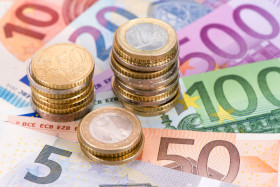The euro is little changed against many of its G10 currency rivals on Thursday after the central bank adopted a wait-and-see approach to monetary policy, leaving its key interest rates and quantitative easing (QE) program unchanged. The European Central Bank (ECB) confirmed it would monitor the strength of the eurozone economy before choosing to add to its suite of stimulus and relief measures.
After its July policy meeting, the ECB announced that it would keep the benchmark refinancing rate at 0%, the deposit rate at -0.5%, and the marginal lending rate at 0.25%. ECB continued to acquire up to â¬1.35 trillion ($1.54 trillion) worth of debt until June 2021 â at the very least â as part of its Pandemic Emergency Purchase Program (PEPP).
ECB head Christine Lagarde stated that she wanted to determine the efficacy of the institutionâs unprecedented policies to shore up the blocâs economy in the aftermath of the COVID-19 pandemic. She did note that the ECB was willing to maintain a âflexible mannerâ over time, but Lagarde added that the ECBâs historically low rates would remain at their âpresent or lowerâ levels until inflation touches its target rate of 2%.
Lagarde also stressed the importance of fiscal policy, encouraging governments to âfocus on accelerating investment in priority areas such as the green and digital transitions.â These targeted investments, she said, would be âparticularly important to rejuvenate our economies.â
Incoming information since our last monetary policy meeting in early June signals a resumption of euro area economic activity, although the level of activity remains well below the levels prevailing before the coronavirus (COVID-19) pandemic and the outlook remains highly uncertain. Both high-frequency and survey indicators bottomed out in April and showed a significant, though uneven and partial, recovery in May and June, alongside the ongoing containment of the virus and the associated easing of the lockdown measures.
The central bank chief also spoke with CNBC following the press conference, telling the business news network that the ECB intends to use the entirety of PEPP and âand make sure that it helps us get back to the trajectory of inflation pace pre-COVID-19.â
On the data front, eurozone industrial production surged 12.4% in May, up from the 18.2% decline in April. This was worse than the market forecast of 15%. The ZEW Economic Sentiment Index rose slightly to 59.6 this month, up from 58.6 in June. The trade surplus narrowed to â¬9.4 billion ($10.75 billion) in May as exports plummeted by 29.5%, and imports fell 26.7%.
The EUR/USD currency pair rose 0.08% to 1.1432, from an opening of 1.1421, at 14:01 GMT on Thursday. The EUR/JPY advanced 0.04% to 122.44, from an opening of 122.25.
If you have any questions, comments, or opinions regarding the Euro, feel free to post them using the commentary form below.
